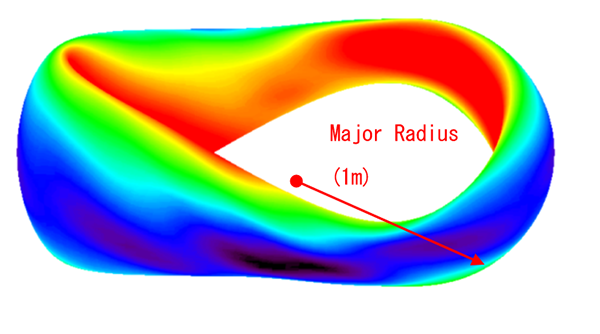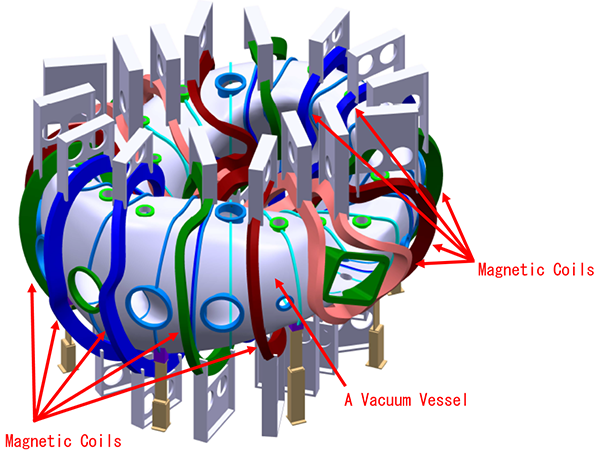HOME > Research Activities > Research Updates >
- Construction of the Quasi-axisymmetric stellarator(CFQS)
National Institute for Fusion Science(NIFS) enters into academic agreements with universities and laboratories around the world to promote many collaborative research projects. In July 2017, NIFS entered into an agreement for international academic cooperation with Southwest Jiaotong University in the People’s Republic of China. Subsequently, the two parties initiated design research towards construction of the first stellarator in the People’s Republic of China. This article introduces this joint project between Japan and China.
For achieving the generation of fusion power, it is necessary to confine high temperature and high density plasma, and to confine that plasma for a long period of time. A plasma is composed of ions and electrons that are charged particles which have characteristics that wind around magnetic fields. Accordingly, by making a cage in the shape of a doughnut connecting both ends of the magnetic fields, it is possible to confine the plasma particles in the cage. However, in the simply shaped doughnut, particles escape from the cage by the action of the curved magnetic fields and the electric fields in the plasma. Thus, it is not possible to confine the plasma for a long period of time. Therefore, by twisting the magnetic field lines to compose the helical structures, it is difficult for the particles to escape and it is possible to confine the plasma.
The devices for confining the plasma with the magnetic fields are classified into the helical device (stellarator) type and the tokamak type by the method for twisting. In the tokamak type, the plasma resembles a simple doughnut and the shape does not change even if it is rotating at the axis of the center of the doughnut. (This is called axisymmetry.) Twisting by applying large electrical currents in this plasma produces the helical structures of magnetic field lines. On the contrary, in helical devices, the magnetic field lines assume a helical shape by twisting the coil and thus producing the magnetic field lines. Thus, the helical device need not apply an electrical current and the plasma resembles a twisted doughnut (not axisymmetry). Because it is extremely difficult to continue applying an electric current in the plasma, it could be said that the helical device which does not require the current in the plasma is excellent for confining the plasma for a long duration. On the other hand, it is thought, theoretically, that plasma particles may easily escape to outside of the cage because the helical device is not in axial symmetry in comparison with the tokamak device.
Thus, in the helical device, maintaining the advantage that it is not necessary to apply currents in the plasma and that the helical device is excellent for confining the plasma for a long duration, design and experiment research of the device that the particles has difficulty escaping have been performed. The Large Helical Device(LHD) of NIFS prevents the particles from escaping by adjusting the currents applied in the coil. This contributes to the achievement of an ion temperature of 120,000,000 degrees Kelvin for the first time in the world in a helical device. Because it is possible to select the shape of the coil freely in the helical device, the device has the possibility to improve the coil and to make escape more difficult for the plasmas. With the maximum use of improving the coil and making escape more difficult for the plasma the “Quasi-axisymmetric helical device" is designed with the advantages of both the helical device and the tokamak device. Although the “Quasi-axisymmetric helical device" has been studied theoretically, this experimental device has not yet been realized.
NIFS is promoting design research for the first construction of the Quasi-axisymmetric helical device (CFQS) in the world as a joint project with Southwest Jiaotong University in the People’s Republic of China. CFQS will be constructed at Southwest Jiaotong University in the People’s Republic of China. In the design of CFQS, first, the shapes of the magnetic field cage and the plasma proper for confinement were determined. Because this requires heavy calculations, a super computer was used. After the shapes of the cage and the plasma were determined, the coil was designed in accordance with those calculations. These calculations and designs introduce many research results obtained from the design research of the Quasi-axisymmetric helical device (CHS-qa) carried out at NIFS. Now, the design research is advancing step by step in order to make a test device for a coil which will generate the magnetic field lines. After the CFQS is completed, much research will be performed from the experiment to prove to confine the plasma better between NIFS and Southwest Jiaotong University. It is expected that many research results achieved at NIFS will greatly contribute to this joint project and the further advance of helical research.

Fig.1 Plasma shape of the quasi-axisymmetric helical device based on calculations by supercomputer. Colors show the strength of the magnetic fields. Red color shows strong magnetic fields, and yellow, green and blue colors show weaker magnetic fields in the order. In standard helical devices, magnetic field is stronger near magnetic coils. In quasi-axisymmetric helical devices, magnetic field is stronger at the inner edge of the plasma and weaker at the outer edge of the plasma independent to the locations of coils. Such structure is similar to tokamak devices. For CFQS, magnetic field strength is 1T and the major radius (the distance from the center of the doughnut to that of the plasma) is 1m.

Fig.2 A schematic image of magnetic coils (colored with blue, green, brown and pink) of the quasi-axisymmetric helical device CFQS and a vacuum vessel (colored with grey) for confining plasma during design now. It is the important characteristic of this device that magnetic coils surrounding the vacuum vessel have complicated shapes.
